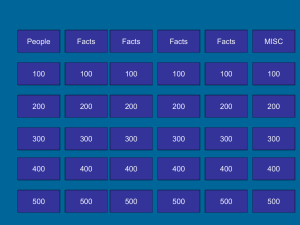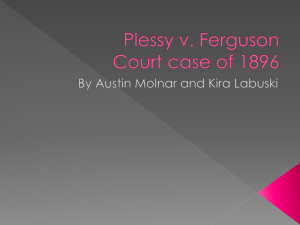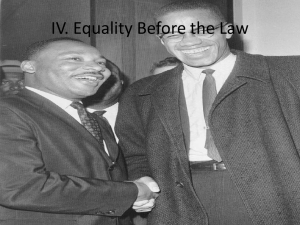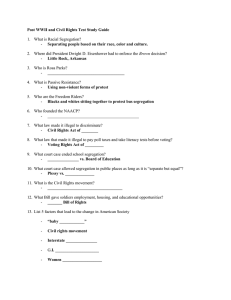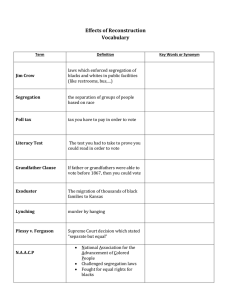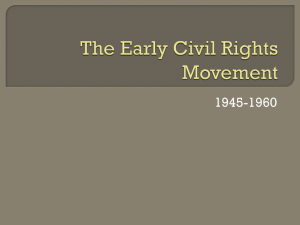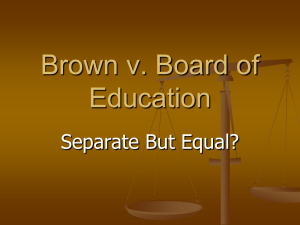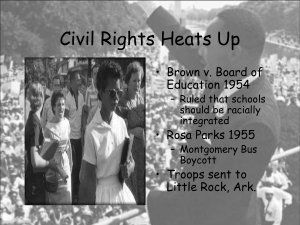Directions- Segregation in America
advertisement
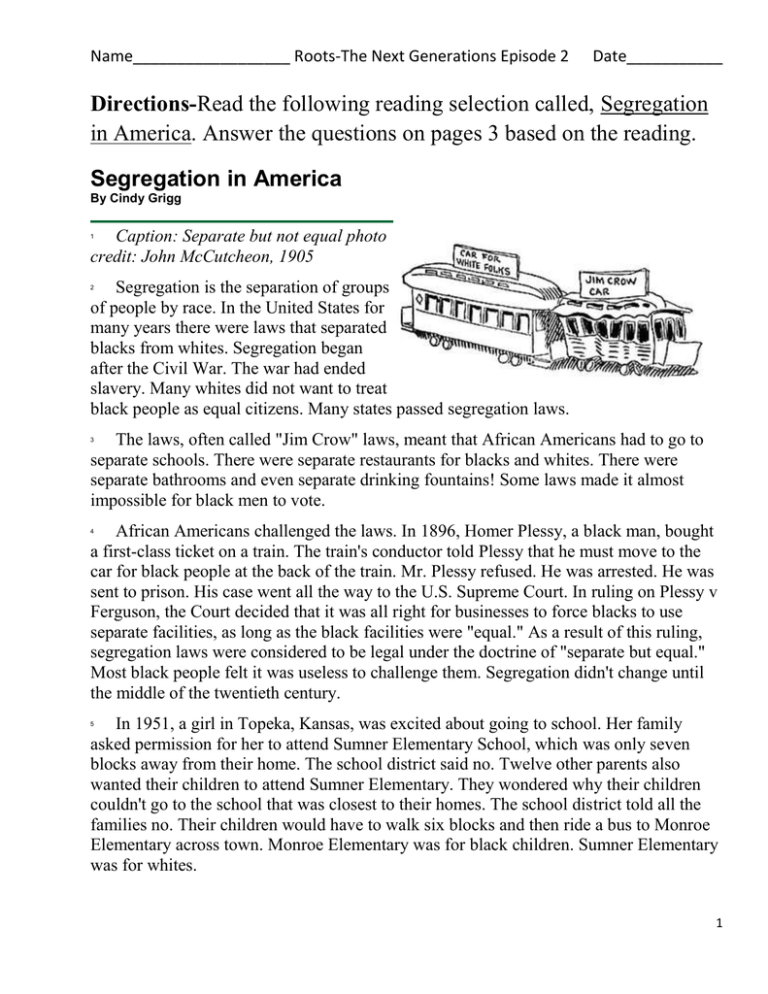
Name__________________ Roots-The Next Generations Episode 2 Date___________ Directions-Read the following reading selection called, Segregation in America. Answer the questions on pages 3 based on the reading. Segregation in America By Cindy Grigg Caption: Separate but not equal photo credit: John McCutcheon, 1905 1 Segregation is the separation of groups of people by race. In the United States for many years there were laws that separated blacks from whites. Segregation began after the Civil War. The war had ended slavery. Many whites did not want to treat black people as equal citizens. Many states passed segregation laws. 2 The laws, often called "Jim Crow" laws, meant that African Americans had to go to separate schools. There were separate restaurants for blacks and whites. There were separate bathrooms and even separate drinking fountains! Some laws made it almost impossible for black men to vote. 3 African Americans challenged the laws. In 1896, Homer Plessy, a black man, bought a first-class ticket on a train. The train's conductor told Plessy that he must move to the car for black people at the back of the train. Mr. Plessy refused. He was arrested. He was sent to prison. His case went all the way to the U.S. Supreme Court. In ruling on Plessy v Ferguson, the Court decided that it was all right for businesses to force blacks to use separate facilities, as long as the black facilities were "equal." As a result of this ruling, segregation laws were considered to be legal under the doctrine of "separate but equal." Most black people felt it was useless to challenge them. Segregation didn't change until the middle of the twentieth century. 4 In 1951, a girl in Topeka, Kansas, was excited about going to school. Her family asked permission for her to attend Sumner Elementary School, which was only seven blocks away from their home. The school district said no. Twelve other parents also wanted their children to attend Sumner Elementary. They wondered why their children couldn't go to the school that was closest to their homes. The school district told all the families no. Their children would have to walk six blocks and then ride a bus to Monroe Elementary across town. Monroe Elementary was for black children. Sumner Elementary was for whites. 5 1 Name__________________ Roots-The Next Generations Episode 2 Date___________ The thirteen families took their case to the courts. It went all the way through the court system. The Supreme Court heard the case, known as Brown v Board of Education, in 1954. All nine Supreme Court Justices agreed. The Court ruled 9-0 in favor of the black students. The Court said that even if the white and black schools were equal in quality, the separation of whites and blacks was unconstitutional. The ruling meant that now black children and white children could go to school together. The case was important because it made segregation in public schools illegal, and it allowed other segregation laws to be challenged. In 1955, Rosa Parks and others challenged segregation on city buses. After the Brown v Board of Education Supreme Court ruling in 1954, things slowly began to change for blacks in America. 6 2 Name__________________ Roots-The Next Generations Episode 2 Date___________ Directions- Segregation in America-Answer the following questions based on what you have read from pages 1-2. 1. Segregation laws were also called: Board of education laws Plessy laws Jim Crow laws Black and white laws 2. The Supreme Court ruled that black schools were unequal to white schools in quality. False True 3. Linda Brown was the only student in the Supreme Court case known as Brown v Board of Education. False True 4. Why was the Supreme Court ruling in Brown v Board of Education important? 5. What was an effect of the Plessy Supreme Court case? Black children could not ride on trains. Segregation laws were considered to be legal. Black children could not go to school. Plessy was not allowed to change schools. 3 Name__________________ Roots-The Next Generations Episode 2 Date___________ Directions-Answer the questions on below based on Episode 2, Roots- The Next Generations. 1. How did Colonel Warner react to his son Jim marrying Carrie, a black school teacher? Explain what he did when he heard the news from his son. __________________________________________________________ __________________________________________________________ __________________________________________________________ 2. Who did Cynthia fall in love with? (Hint: initials are W.P.) __________________________________________________________ __________________________________________________________ __________________________________________________________ 3. What was Will Palmer’s Plans for the future? __________________________________________________________ __________________________________________________________ __________________________________________________________ 4. What happened to Lee Garnett? (Hint: Why was Lee Garnet arrested and working on a “chain gang?”) __________________________________________________________ __________________________________________________________ __________________________________________________________ 5. What did you like least about this movie episode? (Explain your answer.) __________________________________________________________ __________________________________________________________ __________________________________________________________ 4

